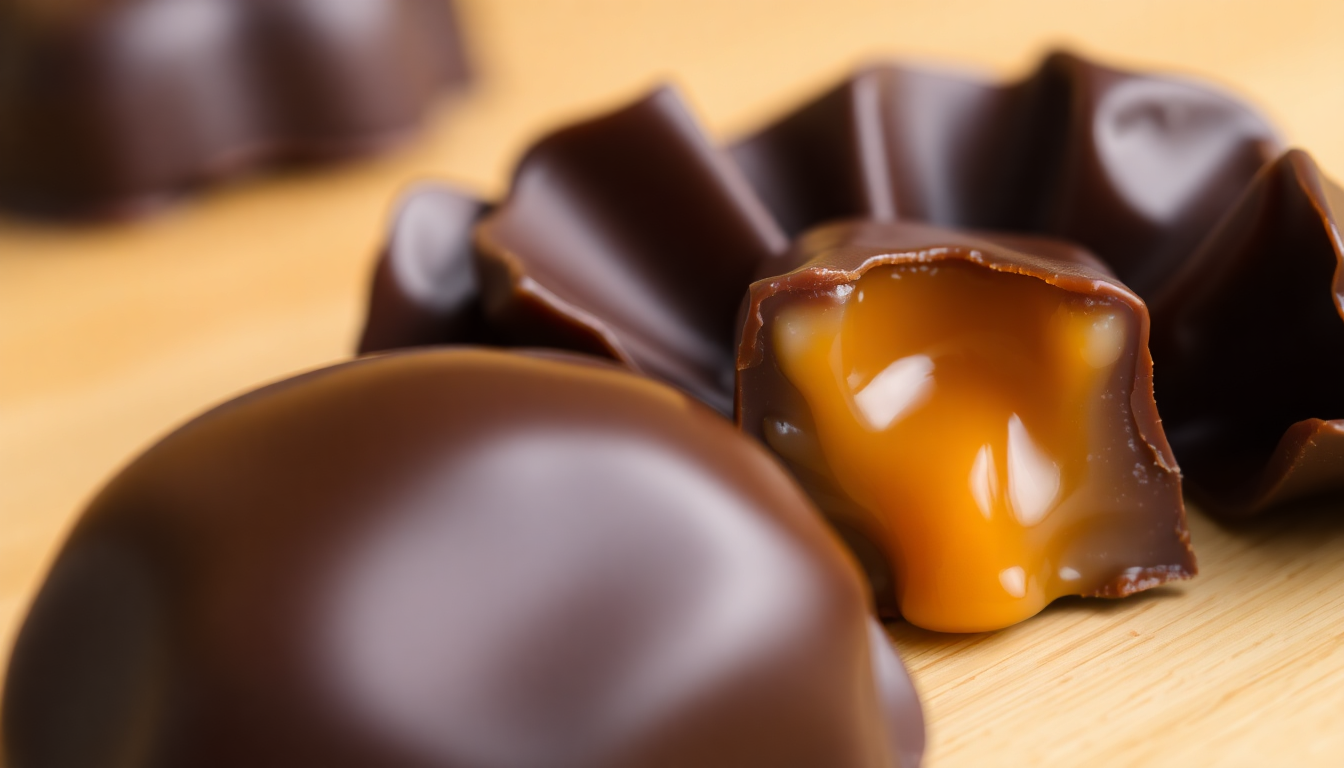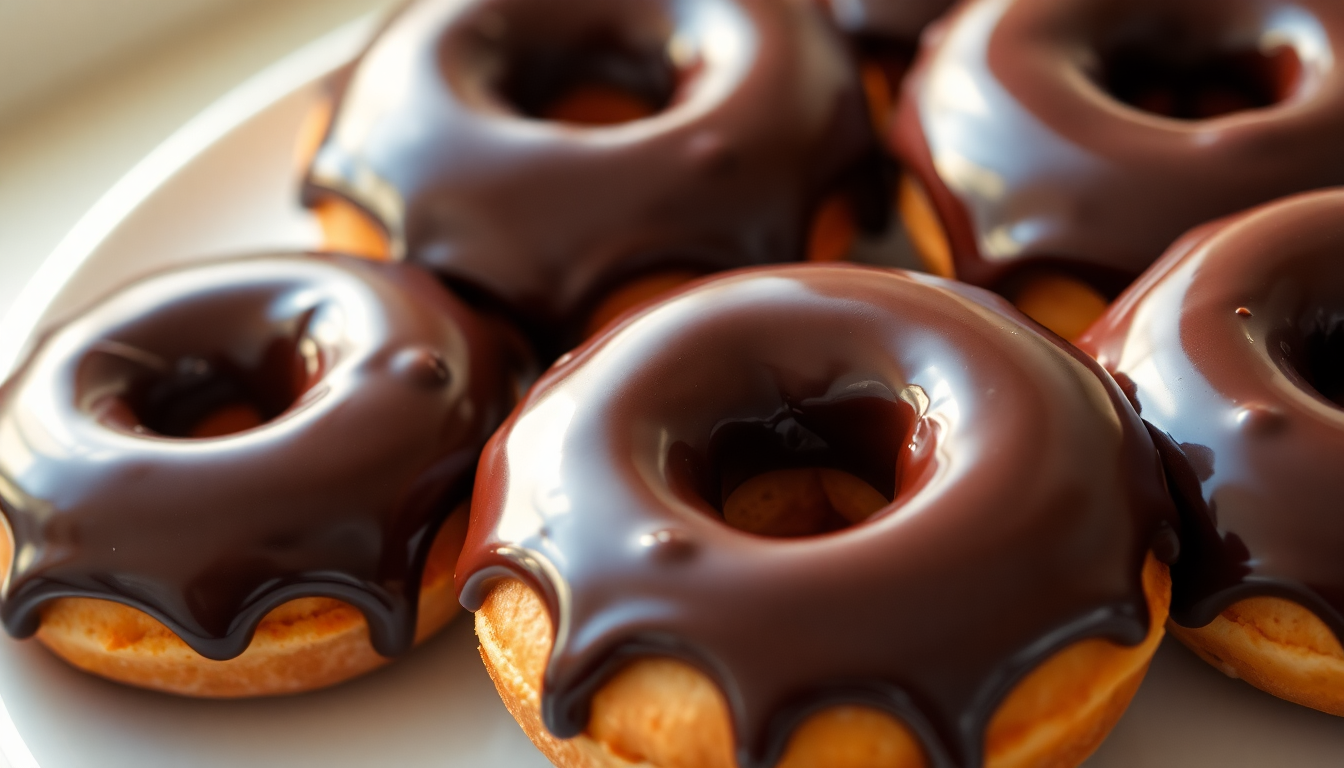
Chocolate Covered Caramel Candy Delight
The Irresistible Union of Chocolate and Caramel
There are few confectionery pairings as universally beloved as chocolate and caramel. This dynamic duo creates a sensory experience that satisfies on multiple levels—the rich, complex flavor of chocolate harmonizing with the sweet, buttery notes of caramel, while their contrasting textures create a perfect balance between smooth meltability and satisfying chew. Chocolate covered caramel candies represent confectionery perfection, combining two of the world's most celebrated sweet indulgences into a single, irresistible package.
The appeal of chocolate covered caramel lies in its perfect balance of contrasts: sweet meets bitter, soft meets firm, and quick-melting meets slow-dissolving. This complementary relationship creates a layered tasting experience that unfolds gradually, rewarding the palate with evolving flavors and textures. Unlike simpler candies that deliver a one-dimensional experience, chocolate covered caramels offer complexity and sophistication while remaining accessible and universally appealing.
Whether enjoyed as an occasional indulgence, given as a heartfelt gift, or served as an elegant dessert accompaniment, chocolate covered caramel candies have earned their place among the world's most cherished confections—a timeless treat that continues to delight generation after generation of sweet-toothed enthusiasts.
The Rich History of Chocolate Caramel Confections
Ancient Origins to Modern Delights
The story of chocolate covered caramel begins with the separate histories of its two star ingredients. Caramel's origins can be traced back to around 1000 AD when Arabian cooks created hard candies by crystallizing sugar in boiling water. This technique gradually evolved into what we now recognize as caramel when milk and butter were added to the sugar mixture in the 17th century.
Chocolate, with its Mesoamerican roots dating back to 1500 BCE, was originally consumed as a bitter beverage by ancient civilizations like the Olmec, Maya, and Aztec. It wasn't until the Spanish brought cacao back to Europe and added sugar that chocolate began its transformation into the sweet treat we recognize today. The development of solid eating chocolate in the 19th century set the stage for chocolate's role as a coating for other confections.
The marriage of chocolate and caramel likely occurred in the late 19th century as confectionery techniques advanced and candy makers began experimenting with combinations of flavors and textures. By the early 20th century, chocolate covered caramels had become a staple in candy shops across Europe and North America.
Cultural Significance Across the Globe
Different cultures have embraced and adapted chocolate covered caramels according to their culinary traditions:
- French Caramels au Chocolat: Often infused with fleur de sel (sea salt) for a sophisticated flavor profile that balances sweetness with savory notes
- Belgian Chocolate Caramels: Typically made with the country's renowned high-quality chocolate for an exceptionally smooth, rich experience
- American Caramel Candies: Frequently incorporate nuts, particularly pecans, for added texture and flavor complexity
- British Chocolate Caramels: Often feature malt notes, influenced by the popularity of malted milk in British confectionery
- Japanese Nama Caramels: Soft, ganache-like chocolate caramels with subtle flavors and less sweetness than Western varieties
These regional variations showcase how chocolate covered caramels have been embraced and adapted worldwide, with each culture putting its unique stamp on this beloved confection.
The Science Behind Perfect Chocolate Caramel Candy
Chemistry of Caramel Formation
The magic of caramel begins with a process called caramelization, where sugar molecules break down under heat to create hundreds of new compounds that contribute to caramel's complex flavor profile and characteristic amber color. This non-enzymatic browning reaction typically occurs when sugars are heated to temperatures between 320°F and 350°F (160°C-177°C).
When making caramel for confections, additional ingredients enter the equation:
- Butter provides richness, mouthfeel, and a silky texture while contributing milk solids that undergo Maillard reactions (another type of browning) for additional flavor complexity
- Cream adds moisture, preventing crystallization while contributing milk proteins and fat that enhance flavor and create a smoother consistency
- Salt acts as a flavor enhancer, brightening the caramel's sweetness and adding complexity
- Glucose or corn syrup interferes with sugar crystallization, helping to create a smooth texture without graininess
- Vanilla complements the caramel's flavor with aromatic compounds that bridge to chocolate's flavor profile
The precise temperature to which the caramel is cooked determines its final texture—from soft and flowing to firm and chewy—allowing confectioners to create the ideal consistency for their chocolate covered creations.
Chocolate Tempering Essentials
The chocolate coating presents its own scientific challenges and opportunities. Proper tempering—a process of controlled cooling that encourages cocoa butter to crystallize in its most stable form (Form V crystals)—is essential for creating chocolate covered caramels with:
- A glossy, attractive appearance
- A clean snap when bitten
- A melt-in-your-mouth texture
- Resistance to bloom (the whitish discoloration that appears when chocolate is improperly tempered)
- Stability at room temperature
Achieving this requires precise temperature control:
- Melting chocolate completely (to around 115°F/46°C for dark chocolate)
- Cooling to approximately 80°F/27°C to encourage crystal formation
- Reheating slightly to 88-90°F/31-32°C to eliminate unstable crystals while preserving the desirable Form V crystals
This meticulous process ensures that the chocolate coating provides the perfect counterpoint to the caramel filling, both in texture and melting properties.
Varieties of Chocolate Covered Caramel Candies
Classic Variations
The traditional chocolate covered caramel appears in several foundational forms:
Square or Rectangular Caramels
The most recognizable format features individually wrapped chocolates in square or rectangular shapes. These classic pieces typically feature:
- A substantial layer of chewy caramel
- A moderate chocolate coating that complements without overwhelming
- Simple, elegant wrapping, often in gold or silver foil
- A balanced chocolate-to-caramel ratio
- Traditional flavor profiles without additional ingredients
These timeless treats form the basis from which all other variations have evolved.
Caramel-Filled Chocolate Bars
Many popular chocolate bars feature caramel as a primary filling:
- Layered bars with caramel sandwiched between chocolate layers
- Chocolate shells containing flowing caramel centers
- Segmented bars allowing for portion control
- Combination bars featuring caramel alongside other fillings like nougat or cookie pieces
This format typically offers a higher chocolate-to-caramel ratio than individual pieces.
Chocolate Caramel Truffles
For a more elegant presentation, chocolate caramel truffles offer:
- A soft ganache-like center with caramel notes
- A thicker chocolate shell
- More delicate textures requiring careful handling
- Artisanal presentations with decorative finishes
- Sophisticated flavor combinations
These upscale interpretations elevate chocolate caramel candies to gourmet status.
Innovative Flavor Combinations
Modern confectioners continue to push boundaries with creative flavor additions:
Sea Salt Caramels
Perhaps the most successful modern innovation, sea salt caramels feature:
- Flaky sea salt (often fleur de sel or Maldon) sprinkled on top or incorporated into the caramel
- The salt amplifies both sweet and bitter notes while providing textural contrast
- Enhanced complexity through the interplay of sweet, bitter, and salty elements
- A more sophisticated flavor profile appealing to adult palates
This contemporary classic has revolutionized the chocolate caramel category over the past two decades.
Spiced Chocolate Caramels
Adding warmth and complexity through spices:
- Cinnamon, cardamom, or nutmeg for warming notes
- Chili for heat that builds gradually while complementing chocolate's flavor
- Chai spice blends for a complex, aromatic experience
- Black pepper for unexpected sharpness and depth
- Ginger for brightness and zing
These sophisticated variations appeal to adventurous palates seeking new taste experiences.
Spirit-Infused Caramels
Alcoholic infusions add complexity and sophistication:
- Bourbon or whiskey caramels with vanilla and oak notes
- Rum caramels with tropical undertones
- Irish cream for additional dairy richness
- Wine-infused caramels that incorporate fruity, tannic complexity
- Liqueur-flavored varieties featuring orange, coffee, or nut notes
These adult-oriented variations transform chocolate caramels into sophisticated after-dinner treats.
Fruit-Flavored Caramels
Fruit additions bring brightness and acidity:
- Orange-infused chocolate caramels, a classic combination
- Raspberry or strawberry for bright, summer flavors
- Banana for tropical sweetness
- Apple or pear for autumnal warmth
- Passionfruit or mango for exotic flair
These variations often incorporate fruit essences, powders, or purées into the caramel itself.
Textural Variations
Beyond flavor, texture provides another dimension for variation:
Soft-Flowing Caramels
These feature:
- A liquid or semi-liquid caramel center that flows when bitten
- A thicker chocolate shell to contain the flowing center
- Often packaged in molded chocolate cups rather than as wrapped pieces
- A dramatically contrasting texture experience
- Sometimes requiring refrigeration for stability
These indulgent treats create a more dramatic eating experience.
Chewy Artisanal Caramels
At the other end of the spectrum:
- Firmer, chewier caramel that provides resistance and lasting presence
- A thinner chocolate coating to balance the substantial caramel
- Often cut into larger, more substantial pieces
- Frequently made with brown sugar or molasses for deeper flavor
- May incorporate additional ingredients like nuts for textural contrast
These substantial candies provide a more prolonged eating experience.
Artisanal vs. Commercial Chocolate Caramel Candies
Distinguishing Quality Factors
Several key factors differentiate fine artisanal chocolate caramels from mass-produced varieties:
Ingredient Quality
Premium chocolate caramels typically feature:
- Single-origin or craft chocolate with distinctive flavor profiles rather than standardized commercial chocolate
- Real vanilla bean instead of artificial flavoring
- Fresh local cream and butter rather than shelf-stable alternatives
- Organic or unrefined sugars that contribute additional flavor notes
- No preservatives, artificial flavors, or texture stabilizers
- Shorter ingredient lists overall
These superior ingredients translate directly to more complex, satisfying flavor experiences.
Production Methods
Artisanal production typically involves:
- Small-batch cooking of caramel allowing for better control and caramelization
- Hand-cutting or -forming of caramel pieces
- Hand-dipping or small-scale enrobing rather than high-volume production lines
- More time-intensive processes that allow for flavor development
- Often made to order for maximum freshness
- Variation between batches, reflecting the handmade nature
These methods honor traditional confectionery techniques while allowing for greater attention to detail.
Ethical Considerations
Many artisanal producers prioritize:
- Ethically sourced cacao that provides fair compensation to farmers
- Sustainable farming practices
- Transparent supply chains
- Local sourcing of dairy and other ingredients
- Environmentally conscious packaging
- Direct relationships with suppliers
These values increasingly influence consumer choices, particularly in premium categories.
Notable Artisanal Producers
Several small-batch confectioners have earned reputations for exceptional chocolate caramels:
Fran's Chocolates (Seattle, Washington)
Known for:
- Gray and Smoked Salt Caramels, reportedly a favorite of former President Obama
- Perfectly balanced salt application that enhances without overwhelming
- Consistently smooth caramel texture
- Elegant, minimalist packaging
- Pioneering the sea salt caramel trend in America
Little Flower Candy Co. (Pasadena, California)
Celebrated for:
- Unusually soft, yet not flowing, caramel texture
- Sea salt caramels with just the right salt distribution
- Vanilla caramels with exceptional aromatic presence
- Small-batch production methods
- Creative seasonal flavors
Recchiuti Confections (San Francisco, California)
Distinguished by:
- Burnt caramel flavor profile with sophisticated bitter notes
- Elegant, thin chocolate coating using proprietary blends
- Distinctive black packaging with minimalist aesthetic
- Balanced sweetness levels appealing to mature palates
- Attention to textural contrasts
Compartes Chocolatier (Los Angeles, California)
Notable for:
- Unexpected flavor combinations like Miso Caramel
- Artistic packaging and presentation
- Celebrity following and high-end positioning
- Use of local California ingredients
- Contemporary twist on traditional confections
Making Chocolate Covered Caramels at Home
Essential Equipment
Successful homemade chocolate caramels require some specialized tools:
- Reliable candy thermometer capable of reading between 220°F and 350°F (105°C-177°C) for precise caramel cooking
- Heavy-bottomed saucepan (preferably copper or stainless steel) for even heat distribution
- Silicone spatula resistant to high temperatures for stirring without scratching pans
- Parchment paper for lining molds and preventing sticking
- Sharp knife dedicated to cutting caramel (often heated slightly)
- Dipping tools or forks for chocolate coating
- Marble slab (optional) for cooling and working with chocolate
- Chocolate thermometer or infrared thermometer for precise tempering
While professional confectioners may use more specialized equipment, these basic tools enable home cooks to create excellent results.
Basic Chocolate Caramel Recipe
This foundation recipe can be modified with various flavor additions:
Ingredients:
- 1 cup (200g) granulated sugar
- 1/2 cup (120ml) heavy cream
- 1/4 cup (60ml) water
- 4 tablespoons (56g) unsalted butter, cubed
- 1/2 teaspoon fine sea salt
- 1 teaspoon vanilla extract
- 8 ounces (225g) high-quality dark chocolate (60-70% cacao), chopped
Caramel Instructions:
- Line a 6-inch square pan with parchment paper, leaving overhang for easy removal
- In a heavy-bottomed saucepan, combine sugar and water, stirring until sugar dissolves
- Once dissolved, stop stirring and cook over medium-high heat until the mixture turns amber (around 340°F/170°C)
- Meanwhile, warm cream slightly in a separate pan or microwave
- When sugar reaches the desired color, remove from heat and carefully add warm cream (mixture will bubble vigorously)
- Add butter and stir until completely incorporated
- Add salt and vanilla, stirring to combine
- Return to medium heat and cook until mixture reaches 248°F/120°C for a firm, chewy caramel
- Pour into prepared pan and allow to cool completely (at least 2 hours or overnight)
- Once set, remove from pan and cut into desired shapes with a lightly oiled knife
Chocolate Coating:
- Temper chocolate using the seeding method:
- Melt 2/3 of chocolate to 115°F/46°C
- Add remaining 1/3 chocolate and stir until temperature drops to 82°F/28°C
- Gently rewarm to 88-90°F/31-32°C for coating
- Dip caramel pieces using dipping fork or toothpick
- Allow excess chocolate to drip off
- Place on parchment paper to set
- If desired, sprinkle with sea salt before chocolate hardens
This recipe yields approximately 16-20 pieces depending on size.
Troubleshooting Common Issues
Even experienced candy makers encounter challenges:
Grainy Caramel
Causes and Solutions:
- Sugar crystallization during cooking
- Prevention: Use a clean pot, avoid stirring after initial dissolution, use corn syrup or glucose (1-2 tablespoons) to prevent crystallization
- Fix: Add water and reheat slowly to dissolve crystals
Too-Soft Caramel
Causes and Solutions:
- Insufficient cooking temperature
- Prevention: Use an accurate thermometer and cook to 248°F/120°C for firm caramels
- Fix: Return caramel to pot and continue cooking to correct temperature
Chocolate Blooming
Causes and Solutions:
- Improper tempering or temperature fluctuations
- Prevention: Ensure proper tempering and stable room temperature for setting
- Fix: Re-temper and re-dip affected pieces
Chocolate Seizing
Causes and Solutions:
- Introduction of water or steam into melted chocolate
- Prevention: Ensure all tools are completely dry; avoid covering hot chocolate
- Fix: Add additional cocoa butter or a small amount of neutral oil to restore fluidity
Pairing and Serving Suggestions
Complementary Beverages
The right beverage pairing enhances chocolate caramel enjoyment:
Coffee Pairings
- Medium roast coffee balances sweetness without overwhelming
- Espresso provides bitter contrast to sweet caramel
- Coffee with chicory (New Orleans style) offers complementary caramel notes
- Cold brew brings out chocolate's fruity notes when paired with darker chocolate caramels
The natural bitterness of coffee counterbalances the sweetness while complementing chocolate's flavor profile.
Tea Selections
- Darjeeling or high-quality black tea provides tannic structure
- Earl Grey's bergamot notes enhance chocolate's fruitiness
- Chai spices complement caramel's butterscotch notes
- Roasted hojicha offers nutty notes that enhance chocolate caramels
Less obvious than coffee, tea pairings can provide sophisticated counterpoints to chocolate caramels.
Wine and Spirit Pairings
- Tawny port offers complementary caramel and dried fruit notes
- PX sherry echoes caramel's richness with its own molasses-like quality
- Bourbon highlights vanilla and oak notes in caramel
- Aged rum with tropical fruit notes complements chocolate's fruitiness
- Sweet Muscat balances bittersweet chocolate caramels
These adult pairings transform chocolate caramels into sophisticated dessert experiences.
Serving Occasions and Presentation
Chocolate caramels shine in various settings:
Elegant Dessert Accompaniments
- Serve alongside simple vanilla ice cream for textural contrast
- Pair with fresh berries for acidic balance
- Include on cheese plates with aged cheeses like gouda or cheddar
- Offer as a sweet finish with after-dinner coffee
- Use as garnish for plated desserts
In these contexts, chocolate caramels should be served at room temperature for optimal texture and flavor release.
Gifting Presentations
When giving chocolate caramels as gifts, presentation enhances their appeal:
- Layer in decorative tins with parchment paper between layers
- Arrange in small paper cups within gift boxes
- Wrap individually in foil or waxed paper for traditional presentation
- Include serving and storage suggestions
- Pair with complementary items like coffee beans or tea
Thoughtful presentation transforms these treats into memorable gifts for any occasion.
Health and Dietary Considerations
Moderation and Mindful Enjoyment
While chocolate caramels are inherently indulgent treats, they can be enjoyed as part of a balanced approach to eating:
- Portion awareness: Appreciating a single high-quality chocolate caramel can provide greater satisfaction than larger quantities of lower-quality confections
- Mindful consumption: Focusing on the sensory experience—texture, aroma, flavor development—enhances enjoyment while naturally limiting quantity
- Planned indulgence: Incorporating special treats like chocolate caramels into an overall balanced diet supports sustainable eating habits
- Quality over quantity: Choosing exceptional chocolate caramels for occasional enjoyment rather than frequently consuming mass-produced varieties
This approach honors both the pleasure of confectionery and principles of balanced nutrition.
Alternative Dietary Options
Modern confectioners have developed alternatives for various dietary needs:
Vegan Chocolate Caramels
Plant-based alternatives typically feature:
- Coconut cream or cashew cream replacing dairy
- Coconut oil or plant-based butter alternatives
- Vegan chocolate for coating
- Sometimes incorporating dates for natural caramel flavor
- Often sweetened with maple syrup or coconut sugar
These adaptations preserve the essence of chocolate caramels while accommodating plant-based diets.
Reduced Sugar Options
For those monitoring sugar intake:
- Maltitol or erythritol-sweetened options
- Stevia-enhanced formulations
- Higher cacao percentage chocolate coatings to reduce sweetness
- Smaller portion sizes of traditional recipes
- Emphasis on salt or spice to reduce required sweetness
These variations allow for indulgence with reduced glycemic impact.
Allergen-Conscious Variations
For those with dietary restrictions:
- Dairy-free options using coconut or other plant bases
- Nut-free formulations for those with allergies
- Gluten-free certifications (though traditional caramels are naturally gluten-free)
- Soy-free options using alternative emulsifiers
- Clear labeling of potential cross-contamination risks
These adaptations make chocolate caramels accessible to those with various dietary restrictions.
Storage and Preservation
Optimal Conditions
Proper storage extends the enjoyment of fine chocolate caramels:
- Temperature: Store between 60-68°F (15-20°C) in a cool, dry place, away from direct sunlight
- Humidity: Maintain relatively low humidity (below 50% ideally) to prevent sugar bloom and moisture issues
- Isolation: Keep away from strong-smelling foods as chocolate readily absorbs odors
- Wrapping: Individual wrapping in waxed paper or foil helps preserve freshness and prevent sticking
- Containers: Store in airtight containers to prevent moisture and odor absorption
Under optimal conditions, chocolate caramels typically remain at peak quality for 2-3 weeks, though they remain safe to eat much longer.
Freezing Guidelines
For longer preservation:
- Wrap tightly in plastic wrap, then foil
- Place in airtight container
- Freeze for up to 3 months
- Thaw slowly in refrigerator, then bring to room temperature before serving
- Note that texture may change slightly, particularly in softer caramels
Freezing works better for chocolate caramels with firmer textures rather than soft or flowing centers.
Conclusion: The Enduring Appeal of Chocolate Covered Caramels
Chocolate covered caramel candies have maintained their popularity across centuries and cultures for good reason. They represent a perfect marriage of complementary flavors and textures, offering a multifaceted sensory experience that few other confections can match. From their humble origins to today's artisanal interpretations, they continue to evolve while remaining true to the fundamental appeal that makes them perennial favorites.
Whether enjoyed as an everyday treat, a special occasion indulgence, or a handcrafted gift, chocolate covered caramels speak to our desire for moments of sweetness and pleasure. The balance they strike—between bitter and sweet, chewy and melting, nostalgic and novel—makes them uniquely satisfying in a world of confectionery options.
In appreciating chocolate covered caramels, we connect to culinary traditions while embracing innovation, participating in a sweet continuity that spans generations and geographies. This beloved confection reminds us that sometimes, the most enduring pleasures come from simple combinations crafted with care and quality—a truth as lasting as the appeal of chocolate and caramel themselves.

Claire Bennett
I'm Claire, a chocolate lover and artisan based in a small town where I run a tiny home kitchen dedicated to exploring everything chocolate. From single-origin dark bars to creamy ganache and handmade truffles, I find joy in working with all types of chocolate. I believe chocolate has a story, and I love bringing that story to life through humble, heartfelt creations.



Leave a comment
This site is protected by hCaptcha and the hCaptcha Privacy Policy and Terms of Service apply.